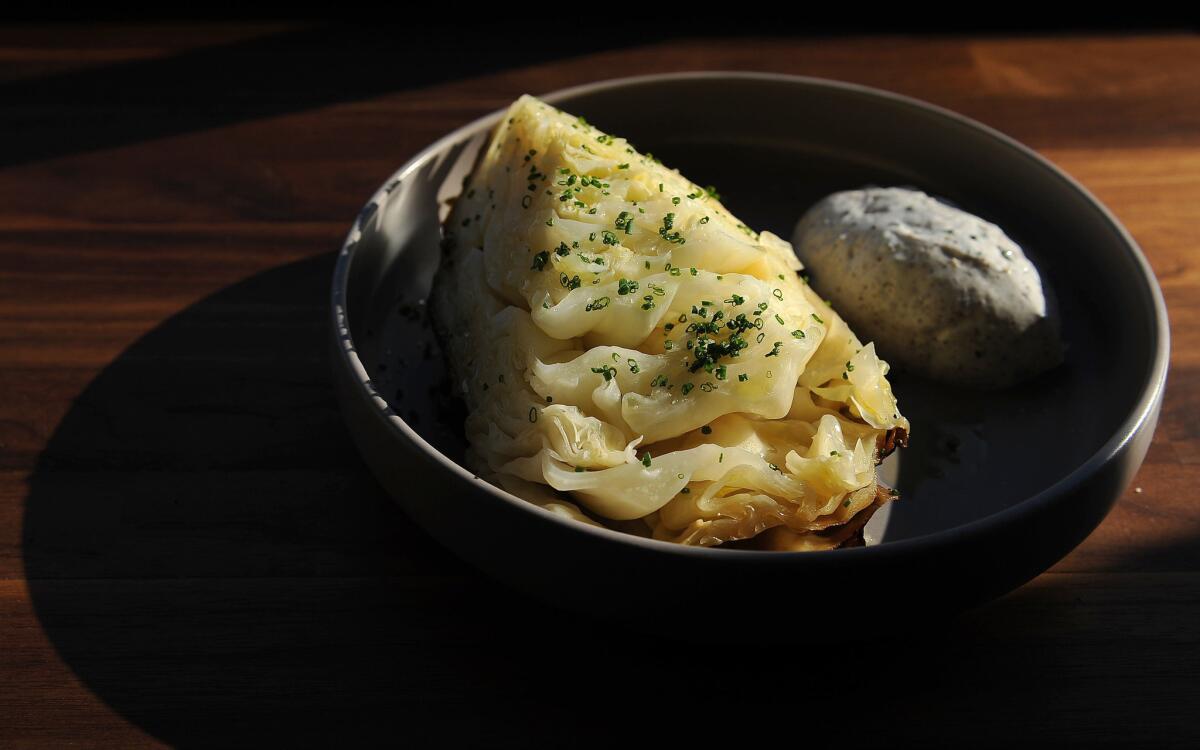Cabbage baked in embers with yogurt, sumac and lemon zest

The weather is a little chilly, the sky more dull shades of gray than bright blue, and it’s actually raining again, thanks to El Niño. Welcome to winter in Los Angeles, where we break out the scarves when the temperature falls below 70 degrees, and even a little rain is enough to stall the freeways. But it doesn’t stop us from grilling.
Far from being just a summer sport, winter is the perfect time to show your grill a little love. Get a batch of coals going or fire up the gas burners, and in minutes you’re ready to roll. There’s nothing like the simplicity of cooking over a live fire, particularly when the weather is less than perfect.
“I love grilling,” Josiah Citrin says. The chef-owner of Mélisse — his venerable Michelin-starred fine-dining restaurant in Santa Monica — has just opened Charcoal Venice, its menu an ode to cooking over live fire. “This is one of those things I’ve been doing with my family for years. It’s real.”
The menu features an assortment of dishes Citrin has perfected for years at home, whether using a wood oven, over charcoal, in the coals — or even using a Big Green Egg. Cabbage baked in embers, one of the starters at the new restaurant, is similar to a camping dish you might remember from when you were a kid. Except instead of wrapping onions or potatoes and tucking them into the burning wood of a campfire, a whole head of cabbage is wrapped in foil and placed among smoldering embers. The cabbage is baked until the outer leaves are caramelized and the vegetable itself is tender. Still warm, thick wedges of the cabbage are served alongside a yogurt dipping sauce flavored with sumac and lemon zest. It’s camping food, but seriously glorified.
It’s all about seasonality for Citrin. “Cabbage is a winter vegetable. There are so many great things to grill this time of year: other winter vegetables, such as endive. And I’m also doing duck that I’ve aged at the restaurant.”
Seasonal produce offers easy inspiration for the grill this time of year. Quickly sear winter lettuces before composing a salad — the char lends an almost meaty depth to the dish. Toss winter vegetables, such as broccoli, cauliflower, Brussels sprouts or onions, with a little oil before grilling in a perforated pan or wrapping them in foil, cooking them until they’re tender and caramelized. Grill thick wedges of seasoned sweet potatoes on a rack until the outsides are blistered. Or grill slices of citrus to add a touch of smoke to their bright fruit flavor.
You may not be grilling aged duck at home, but you could try slow-smoking duck over a low fire, or maybe ribs, brisket or chicken.
And when the weather isn’t so cooperative, part of the beauty of the grill is that so many foods cook quickly, with minimal mess and cleanup. For a quick dinner, try a classic grilled “brick” chicken. It’s an old cooking method, and it goes by a number of names, like “chicken under a brick” and “spatchcocked chicken.” The technique is simple: Cut the backbone out of a chicken, and flatten the bird out, much like opening a book. (You can do this yourself or have your butcher do it for you.) Season and grill the chicken, skin-side down, keeping the chicken flat under a heavy brick, paving stone or cast-iron skillet. The chicken cooks in less time than it would normally take to grill or roast a whole chicken, and you’re guaranteed crispy skin throughout.
And because it is winter, you’ll want to make sure you have enough fuel on hand, as the weather can be cold (at least for Angelenos), and it can take longer for your grill to heat. But please skip the scarf.
Sauce
In a mixing bowl, combine the yogurt, lemon zest, sumac, chives and lemon juice and mix well. Transfer to a container with a tight-fitting lid and keep cold.
Cabbage
Start a batch of hard lump charcoal in a grill or barbecue, watching for all of the coals to turn red, 20 to 30 minutes.
Meanwhile, bring a pot of water to a boil. Add 1 tablespoon salt per quart of water. Add the cabbage to the water and boil for 1 minute. Immediately remove the cabbage and transfer to an ice bath to cool.
Dry off the cooled cabbage and drizzle all over with oil. Wrap the cabbage in foil and place directly in the coals, rotating every 5 minutes for 1 to 1 1/4 hours. Remove and set aside to cool for 10 minutes. Cut the cabbage into quarters and place on a platter, sprinkling the cabbage with fleur de sel. Have guests tear pieces of cabbage with their fingers, dipping the cabbage into the sauce.
Get our Cooking newsletter.
Your roundup of inspiring recipes and kitchen tricks.
You may occasionally receive promotional content from the Los Angeles Times.
















